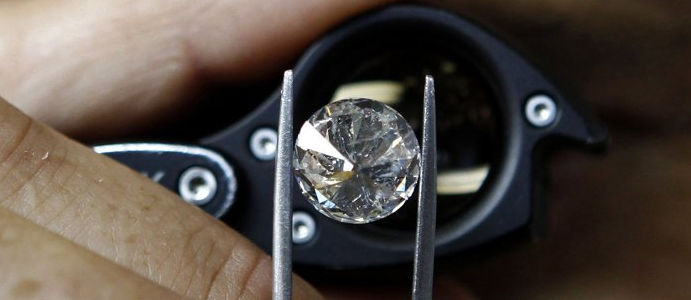
Have you ever wondered how to grade the quality of diamonds?
Introducing The 4 C’s
The 4 C’s are a simple introduction to diamond grading. To learn about the 4 C’s: click here. This page explains the criteria of the basics of diamond grading, with more pages going into deeper detail of the meanings.
Click the links (underlined) to learn more about each of the 4C’s.
Diamond clarity refers to the degree to which a diamond is free from internal inclusions (tiny imperfections within the stone) and surface blemishes. Inclusions can range from tiny crystals to larger fractures, and they can affect a diamond’s overall appearance and value.
Diamond color refers to the presence or absence of color in a diamond, with the most valuable diamonds being those that are completely colorless. A diamond’s color is graded on a scale from D (colorless) to Z (light yellow or brown), with grades closer to D being more valuable.
Diamond carat is a unit of measurement used to describe the weight of a diamond. One carat is equal to 0.2 grams or 200 milligrams. In the diamond industry, carat weight is one of the four “C’s” used to evaluate the quality and value of a diamond, along with clarity, color, and cut.
Diamond cut refers to the quality of a diamond’s proportions, symmetry, and finish. It is one of the 4Cs of diamond grading, along with carat weight, color, and clarity. A well-cut diamond will reflect and refract light in a way that maximizes its brilliance, fire, and scintillation, making it appear more sparkling and attractive.
Other Grading Criteria
Diamond fluorescence refers to a diamond’s ability to emit light when exposed to ultraviolet radiation. The light emitted usually appears blue, though it can also take other colors. The strength of fluorescence varies among diamonds and is graded from None to Very Strong. While fluorescence can contribute to a diamond’s uniqueness, it can also sometimes make a diamond appear hazy or oily under natural light, especially in diamonds with Very Strong fluorescence. However, in many cases, fluorescence does not greatly impact a diamond’s appearance to the naked eye.

Diamond grading companies, such as the Gemological Institute of America (GIA), the American Gem Society (AGS), and the European Gemological Laboratory (EGL), provide unbiased assessments of a diamond’s quality. These organizations evaluate diamonds based on the Four Cs: Carat weight, Color, Clarity, and Cut. The grading reports they issue include detailed information about a diamond’s characteristics and quality. These grading reports are critical for both buyers and sellers, as they provide a standard for assessing a diamond’s value and ensuring transparency in diamond transactions.
Diamond inclusions refer to internal characteristics or imperfections within a diamond. These can be tiny crystals, feathers, or fractures and are natural results of the diamond’s formation process. Inclusions can affect a diamond’s clarity grade, one of the Four Cs used to evaluate a diamond’s quality. While some inclusions can be seen by the naked eye, many are microscopic and require magnification to observe. Inclusions can influence the brilliance of a diamond; however, they also make each diamond unique, akin to fingerprints for humans.
More About This Page
In this page, we explain the all the basic information regarding grading the quality of diamonds as defined by the standards of the GIA. Things we explain on this page are how to differentiate in different levels of fluorescence and their effects on the color of diamonds. We also explain the importance of cut, polish, and symmetry. On top of that, we also teach you how to differentiate between different clarities,
Knowing the basics of diamond grading is a helpful tool to help you pick the perfect one for you.
The Benefits Of Learning To Grade Diamonds
Diamonds are one of the most sought-after and valuable gemstones in the world, prized for their rarity, beauty, and enduring value. As a result, the diamond industry is a complex and competitive market, with a wide range of players including miners, cutters, wholesalers, and retailers. For anyone looking to enter this industry or make a purchase, having a solid understanding of how to grade diamonds can be a valuable asset.
Grading diamonds involves evaluating their characteristics and assigning a grade to each one based on a set of standardized criteria. The most important factors in grading diamonds are the 4Cs: cut, clarity, color, and carat weight. Understanding how to evaluate each of these factors is essential for anyone looking to buy or sell diamonds, whether as a professional or as a consumer.
Making Better Decisions To Optimize Value
For buyers, knowing how to grade diamonds can be extremely beneficial in several ways. Firstly, it can help them to make more informed purchasing decisions, as they will be able to evaluate the quality and value of a diamond based on objective criteria rather than simply relying on the seller’s claims. This can help to ensure that they are getting a fair price and that they are purchasing a diamond that meets their desired standards.
Secondly, being able to grade diamonds can also be useful for identifying potential scams or fraudulent activities. Unfortunately, the diamond industry is rife with scams and fakes, and knowing how to accurately evaluate a diamond can help buyers avoid being taken advantage of by unscrupulous sellers.
For those looking to enter the diamond industry as professionals, knowing how to grade diamonds is essential. Diamond graders are responsible for evaluating the quality and value of diamonds, and are employed by a variety of organizations including diamond mines, wholesalers, and retailers. By developing expertise in diamond grading, individuals can position themselves as experts in the field and open up a wide range of career opportunities.
The Benefits Go Beyond That Of A Buyer
Furthermore, those who are able to accurately grade diamonds can also potentially earn higher salaries or commissions, as they are able to negotiate better deals and offer more value to their employers or clients.
In summary, knowing how to grade diamonds is an incredibly valuable skill that can offer a wide range of benefits for both consumers and professionals. Whether you are looking to purchase a diamond for personal use, start a career in the diamond industry, or simply develop your knowledge of gemstones, learning how to grade diamonds is a worthwhile investment of time and effort.

10 Reasons Why Knowing Diamond Grading Can Be Practical
- Informed Purchasing Decisions: Understanding diamond grading can help you make educated decisions when buying a diamond. You’ll be able to accurately assess the value of a diamond based on its grade.
- Budget Management: Diamond grading knowledge can help you manage your budget. You can find a diamond that fits both your quality standards and your budget.
- Identifying Inclusions and Blemishes: Grading reports provide details about a diamond’s inclusions and blemishes. By understanding grading, you can determine how these features might impact a diamond’s appearance and value.
- Assessing Diamond Cut: The cut grade influences a diamond’s brilliance. Knowing how cut impacts grading can help you choose a diamond with the best possible sparkle.
- Evaluating Color and Clarity: Understanding how color and clarity grades affect a diamond’s quality helps you balance these factors against each other, based on your preferences.
- Insurance Purposes: Insurance companies may require a diamond grading report to insure jewelry. Understanding the report can help you ensure your investment is adequately protected.
- Resale Value: If you ever decide to sell a diamond, knowing its grade can help you set a fair price and negotiate effectively.
- Understanding Fluorescence: Diamond grading includes an assessment of fluorescence. This knowledge can help you decide if a fluorescent diamond is right for you.
- Ensuring Ethical Sourcing: Many grading reports include information about a diamond’s origin. Knowledge of diamond grading can help you ensure you’re buying ethically sourced diamonds.
- Appreciating Natural Variations: Learning about diamond grading can enhance your appreciation for the unique features of individual diamonds. Every diamond is one-of-a-kind, and understanding grading can help you fully appreciate these natural variations.